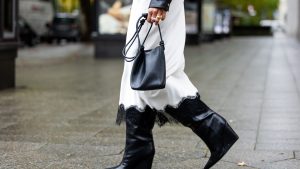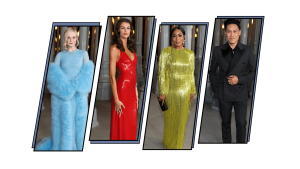
From the Archives: The Fast—and Fashionable—Florence Griffith Joyner
“Go with the Flo,” by Stephanie Mansfield, was originally published in the April 1989 issue of Vogue.
For more of the best from Vogue’s archive, sign up for our Nostalgia newsletter here.
She streaked across our television screens in fuchsia and lime, all hair and lips and eyes with those nails; you would swear you were watching a Solid Gold dancer, not the winner of three gold medals in last summer’s Olympic games.
She is Flo-Jo, the fastest and flashiest ever to come out of the starting block. She can outrun O. J. Simpson, do three thousand sit-ups at a time, as well as partial squats holding 320 pounds, all without disturbing her ladylike pearl stud earrings, and still find time to stencil tiny palm trees and sparkling things on her fingernails. Blessed with speed and style and defiant sexuality, Florence Griffith Joyner has broken down the barrier between vanity and athletic prowess and is living proof that one needn’t cancel out the other.
“You can sweat and still look nice doing it,” says Griffith Joyner, taking time out from packing for a trip to Europe to talk about her eccentric fashion sense on the track and field, an arena where she sprints into home-stretch in a grape spandex one-legger under patterned bikini bottoms, her lips glossed a high raspberry sheen. “I love bright colors,” she says. “There’s a lot of energy there. The color fires me up.”
At twenty-nine, Griffith Joyner is disciplined and direct, with a girlish laugh and a voice currently undergoing diction lessons, the promise of lucrative film and TV offers looming in her future. (There are also acting and dialogue coaches.) Her hair is often a massive tangle of black curls, her nails are expertly polished, her huge brown eyes peer out from spidery lashes, and her skin is cocoa-butter smooth. On her left hand is a diamond ring on which Brian Boitano could do figure eights. And those legs! She has thigh muscles to rival the best in the NFL, and arms like two pump-action carbines. G.I. Flo.
As a child, growing up in the projects of Los Angeles, Griffith A Joyner liked to wear hair ribbons and play dress-up. Appearance was always important. Her mother insisted her hair be combed, her face washed, tier clothes pressed. She also became devoted to a succession of Barbie dolls. “We don’t just play with those dolls,” she reflects. “They have something to do with how we feel about life and how we look at other women.” Young Dee Dee, as her family called her, escaped the pain of poverty with a fantasy world of beauty and cosmetics. “I remember doing a lot of dolls’ hair. I destroyed a lot of dolls putting my mom’s hot curlers on them. I burned up so many of them.”
It comes as no surprise that her grandmother, Gertrude Scott, at eighty-four still works as a beautician. Her mother, Florence, a seamstress, was also a major influence. “My mother always wanted me to be different. She made all my dresses as a young girl.” She taught her daughter “to be unique” and encouraged her to invent her own style. “I always tried to create a different pattern. Something no one else had. To be a great designer, that was one of my dreams.”
Griffith Joyner—who now can afford Valentino and Balenciaga—remembers shopping trips as a young girl.
“I would say, ‘Mom, I want to get some shoes like my friend or a dress like that,’ and my mother would always say, ‘Don’t you want something different?’ ” Griffith Joyner laughs. “She’d say, ‘It’s easy to look alike; but when you look different, that’s special.’ I guess I’ve always been into something more special.”
Griffith Joyner discovered running at the age of seven. “I never liked the outfits they wanted us to wear: T-shirts and shorts. The T-shirt was cute, but I’d roll up the sleeves or tie up the front, just to do something different.”
Off the track, Griffith Joyner’s personal style was just as different. She’d go to the mall with her pet boa constrictor wrapped around her neck, muffler-style. “They used to laugh at me. I’d wear one green sock and one blue sock. One rolled up, one down. Braid my hair at the top, sticking straight up. Even today, people laugh at things I wear. I became immune to the criticism.”
Griffith Joyner knew how to sew, so she began making her own running outfits, buying bright accessories for more impact. “When I first wore a bodysuit, everybody said, ‘That will slow you down.’ I didn’t believe it. I was more into fashion than I was into worrying about its slowing me down.”
The negative response, she has concluded, stems from a natural reluctance on the part of most athletes to be seen as something less than serious. “I think it’s the fear. People always ask me, ‘Why do you wear that?’ A little bit of lipstick is not going to make you run slower.” She pauses. “If you believe something will hamper your performance, it will. It’s all a state of mind.” Griffith Joyner’s own state of mind can only be described as Frederick’s of Hollywood. Teammates were shocked by her lacy white pantyhose (she calls it an “athletic negligee”), not to mention her one-legged unitard.
“Actually, it was going to be a different outfit, but when I cut off one leg, I thought, ‘Wow, that’s different.’ I looked in the mirror and put shorts over it.” The shorts look like a sexy diaper. “You just roll it down,” she laughs. “That’s the new style.”
Photographed by Irving Penn, Vogue, April 1989
Griffith Joyner, married in 1987 to 1984 Olympic triple-jump champion Al Joyner, wore the one-legger to the July trials. “Critics said it was too flashy, not track-and-field-like. The other girls couldn’t take the criticism. I just laughed it off.”
While her sister-in-law, gold medalist Jackie Joyner-Kersee, projected a more conservative image, Griffith Joyner reveled in her own flamboyance. Her peers “have grown used to my wearing different outfits. Some of my closest friends want to know, ‘What are you wearing today? How revealing is it? Let us see it.’ I say, ‘No, you have to wait till I take off my sweats.’ ”
From November to December, Griffith Joyner concentrated on “a lot of mileage” (long runs), as well as bike riding and weight lifting to maintain that muscular body, described by one sportswriter as certain to predict “the look that the twenty-first-century woman would covet.” In February she began to work on the track. She rises early, runs for three miles, practices on the track for nearly three hours, retreats to the weight room for about two hours, goes home to her Newport Beach, California, condo and eats a pasta dinner before a night run.
“I can basically eat anything I want, in moderation. For dinner, I usually cook spaghetti, dinner rolls, maybe some broccoli.” She rarely drinks, although when she and Al celebrate on the tenth of every month (the calendar date of their wedding) it may be with a glass of champagne.
For the record, her fingernails are definitely her own; but she paints them with a thin coat of acrylic. “I once let them grow to six inches,” she laughs. “I’ve always admired women with long fingernails. When I was a young girl, my mother had a friend with long fingernails. I was just attracted to them.”
At 5’7″ and 130 pounds, Griffith Joyner usually wears a size six or eight, and off the track likes Anne Klein clothes. “I like a soft look, not outfits with ruffles everywhere. Anne Klein makes calm clothes, cream colors, earth tones.”
She and her manager are sorting through the offers that have poured in since Griffith Joyner took home three gold medals and a silver at the Summer Games. (Advertisers have already dubbed her Cash Flo and say she could take home as much as one million dollars a year.) Florence did a guest shot on the TV show 227 and recently did a screen test for Norman Lear. She will also design her own line of activewear. Two Japanese firms, Mitsubishi and Mizuno, will have her endorsing televisions and athletic shoes, respectively; and it is likely that her image here at home will be on everything from soft drinks to cosmetics later this year. (She turned down a request to endorse a headache remedy, wanting to avoid even the slightest drug-related image.)
Perhaps Griffith Joyner’s strangest commercial enterprise is her Flo-Jo doll. It will compete with her beloved Barbie. “They’re trying to make her look just like I do. She’s going to have nails you can put on. The hair, the makeup.”
And what about those un-Barbie-like gluteals and hamstrings? Griffith Joyner laughs. “I don’t think they’re putting in the muscles.”











